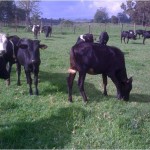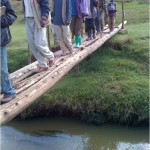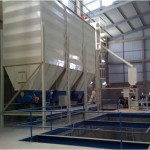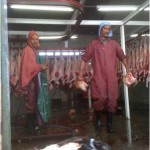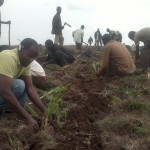As part of Morrell Agro Industries’ plan to relieve famine in Ethiopia, a livestock initiative was created. Improving the animal quality and production in Ethiopia is one of the most important issues that Morrell Agro Industries has been striving to accomplish. The average dairy cow in Ethiopia produces about a half gallon of milk each day. That amount could easily be doubled or tripled to five or six gallons per day if additional genetics are brought into the country.
Holstein cattle, which are a common breed in the United States, don’t do as well in starvation mode, which is typical for cattle in Ethiopia, as the native Arsi cattle do. Research centers in the country are producing half-Holstein, half-native cattle crosses so that they produce more milk than the native cattle and hold up better in tough environments than the Holstein cattle.
But, if Holstein cattle are feed correctly, they can perform fantastic in the country. Kokosa is a tremendously great environment for dairy cattle. Nothing like it can be found in the United States, where it is either too hot or too cold for dairy cattle. Ethiopia is great country, and MAI is excited to see what they can accomplish there. The first step is to improve the cattle breeds in the country.
Lonny Ward, the employee of MAI who began the Kokosa project, utilized the methods of embryo transplant and artificial insemination to build a herd on the property. The initiative plan included taking over frozen embryos from the United States and implanting them in the native Ethiopian cattle. From those animals, a 300 cow dairy would be created. If successful, a calf with 100% US genetics could be born in Ethiopia. Semen from the United States was also brought in to Ethiopia and bred with the native cattle, which results in a half US genetics calf. The end goal of utilizing both embryo transfer and artificial insemination is to increase cattle production and quality throughout the country.
The first successful embryo transfer in Ethiopia, resulted in the birth of a Holstein-jersey calf at the Adami Tulu Animal Research Center in the beginning of May. Five more calves have since been born.
In April 2010 eighty frozen embryos that were imported the previous August were implanted in the native cows. The recipient animals were in good condition, so Lonny was optimistic that they would have good success. He was concerned when he found a small amount of ice in two of the goblets containing the embryos, which was only a shadow of what was to come. It appears that someone opened the tanks with the embryos and poured some water in, killing all of the embryos. Consequently, there were no pregnancies from any of those embryos. Fortunately during that time Lonny had left one goblet of embryos at the Holeta research center, which were untainted, resulting in two pregnancies.
Lonny started the project with 130 embryos and ended up with 13 pregnancies. This statistics are terrible by US standards but not bad for Ethiopia where ET has been a significant challenge.
The biggest milestone made so far in Kokosa is that the milk produced on the farm is now being marketed. About 20 Boran cows on the farm are being milked. None of Morrell Agro Industries’ cows with improved genetics are old enough to start milking, yet.
Jersey cattle will also be imported from Kenya, as MAI found that they can be purchased for a good price. Jersey cows will produce a higher butterfat and higher protein milk. This kind of milk is better for making butter and cheese. MAI plans to purchase about twenty of these Jersey cows.
The goal is to build a herd that can produce more milk than typical Ethiopia cattle so that a productive and profitable dairy can be built in the area that could handle about twice the milk that the dairy would produce.
The milk and the butter have been selling well. They do not have the equipment to make cheese yet, but there is a large market for dairy products in Ethiopia. If these products are collected, processed, or made, they are easy to sell. MAI hires local Ethiopian people to work on the farm, milking cows and churning butter. Marty Petersen added that while milk is common in the local markets, and regularly consumed by the Ethiopian people, cheese is not typically eaten. Marty Petersen said, “We’re producing something that is not a staple in their diet. It may or may not work. If they start consuming it, it should be good.”
As Lonny Ward and Tsehay Redda discussed plans for the Morrell Agro Industries dairy in Kokosa, it was decided to scale back on the size of the dairy to be built. The resources and challenges presented in Ethiopia are not conducive, at least at the time, to a building a successful, large-scale facility. It was decided that a small-scale milking facility and a small milk processing facility, in which to make cheese, would be built on the property.
As of July 2011, Tsehay, Abera, and their team have finalized the plans to begin construction on a modern dairy facility at Kokosa farm. They expect to break ground in the coming weeks, and are preparing to import purebred dairy animals from Kenya to provide the foundation for this effort.
MAI has begun to purchase milk processing equipment, although it will be at least a few months before the equipment is obtained which is needed to make cheddar cheese.
May 2011 Progress
As of December 2010, there were 56 cows, six of which were pregnant on the MAI dairy farm in Kokosa. There were also 39 calves (24 females and 15 males). On an average week on the farm, 92.25 liters of milk were produced. In May of 2011, 55 culled cows were sold. As of July 2011, there are currently 37 calves and two cows on the farm. At the moment, there is no milk production.
One hectare of highland corn, to be used as silage, was also planted in May.
Materials for barn construction arrived on the farm in May 2011. Barn construction in Kokosa has not begun, yet. Seeds of greenleaf, clover, vetch, oats, and highland leucaena had also been purchased for use as forage.
In the meantime, Abera and his team continue to work on pasture and infrastructure improvement projects to make Kokosa a model of operation. They have also started to host community training and outreach programs to help train local dairy farmers on the best practices so that when we implement our milk processing facility, we will be able to buy milk from the surrounding farms, as well as use all of the milk from our own dairy. They discussed management systems and various varieties of forage crops, along with site selection, land preparation, planting methods, weed control, harvesting, hay making, and storage. A field visit and practical work demonstrated to the farmers how to plant alfalfa and other forage varieties. In doing this, we build MAI and the community, and everyone wins.
September 2011 Progress
Over the last several weeks, corn, clover, Luceanea, Jefferson wheat, and vetch have all been sown on the MAI farm in Kokosa. Treatments have also been given to newly purchased calves, which have been sick. Harvested grass was sold for a total of 800.00 burr.
Additional progress made in Kokosa:
- Fodder beets were transplanted from seed beds to the land.
- One kg each of Ryegrass, Meadow Bromegrass, Sainfoin, Orchard grass, Wheatgrass, and Bird’s-Foot Trefoil were sown on the farm. These varieties came from the USA for trial.
- Weeds in the alfalfa fields were removed by hand, to keep them from overpowering the crop.
- Six daily laborers were hired to cultivate Napier grass.
- Land next to the quest house on the farm was prepared for the transplanting of cabbage seedlings.
- Weeds were removed from pasture land on the farm. It will be burnt once it is dry.
- The electrical line between Kokosa and Hurufa was fixed.
October 2011 Progress
The priorities at the Kokosa Dairy Development Project remain focusing on barn construction, following up on land issues, and following up on electrical issues.
Progress continues to be made at the farm, including the following:
- Abera traveled to Addis to work on land issues, financial reports, and to finalize the issues involving construction of the barn, milking area, and calf pen. A solution was found for the milking area and calf pen.
- An engineer will be hired to construct the barn, milking area, and calf pen.
- There are still a few issues with getting electricity. There is a finalized estimation, and hopefully the issue will be resolved soon.
- A follow-up on the performance of the bulls, cows, and calves revealed that they are in good condition.
- Additional antibiotic treatments were given to the fourteen sick calves.
- Fodder beet transplanting was finished.
- A closer grazing area was opened.
- Napier grass, which was planted by root split, was cultivated. It is growing well.
- Maize variety BH 660 was cultivated.
- Weeds were removed from alfalfa, oats, and vetch land.
- Weeds were also cleared from pasture land, and clearing work will continue.
- Due to a poor fence, there has been some difficulty controlling the entrance to the community animals.
- Land issues continue to be worked on.
November-December 2011 Progress
The priorities on the farm remain to solve the land issues and work out the project budget. Progress this month includes the following.
- Staff from Kokosa participated in the Shashamene and Mojo field day.
- Staff held a general meeting with the surrounding community and discussed the importance of the dairy extension and establishing a dairy co-op. More than 100 farmers and Woreda cooperation officers participated in the meeting.
- The electric installation plan was completed.
- Farm calves were measured in heart girth. Numbers were then submitted to the Marketing Department.
- A follow-up on the performance of bulls, cows, and calves was completed. They are in good condition.
- Sick calves were given a treatment of antibiotics.
- A closer area for grazing was opened, managed by a paddock system.
- Napier grass, which was planted by root split, was cultivated. It’s growing well.
- Maize, variety BH 600, was cultivated.
- Weeds were removed from alfalfa, oats, and vetch land.
- Weeds were cleaned from pasture land, and the pasture was developed.
- Staff met with the community to discuss controlling the entrance of community animals onto the farm.
- Staff are working on collecting field crop data from the Shashamene and Mojo project.
- The performance of the farm’s bulls, calves, and cows was evaluated. Almost all of the local cattle breeds had better body condition than the exotic cattle breeds. This was particularly true this week as there was a heavy rain, and the cattle were shocked by the cold; what they ate they used for cold resistance. The local breeds were able to resist the harsh environment.
- The animals were transported to an Addis slaughterhouse to be sold at the Addis supermarket.
- The heart girth of 53 bulls and heifers, both exotic and local breeds, was measured before they were started to be given concentrated feed. Concentrate feed was purchased from the Kalit Animal Feed Processing Factory and was mixed with alfalfa and green feed.
- At this time, the oats mixed with vetch is ready for harvesting. Daily laborers will be hired within one week before the crop has fully flowered.
- The farm’s Napier grass was invaded by weeds. The weeds need to be removed from the Napier land in order to reduce competition for nutrients and free air circulation.
- The Jefferson wheat special plots one and four are in good condition. Those two plots are fully ready for harvesting. Jefferson wheat has adapted well to the Kokosa environment, and it is possible to use it in large scale projects, rather than just demonstrations.
- Bulls, calves, and cows were treated with oxyteracycline 20% and ivermitine.
Future Plans
Staff will follow up on the Kokosa land issues with the head office team in order to get the issues solved and finalized. They will also follow up on the performance of calves on the farm, giving treatments to sick animals as needed. A water installation survey will be completed, as well.
Shashamene Projects
According to the crop planting calendar, Shashamene staff plan to produce a crop two times each year.
A. Phase One: June 2011
| Crop Type | Cultivated Area | Yield/Hectare | Total Yield | |
| FTC | Potato | 0.5 ha | 78 qt | 39 qt |
| School Farm | Potato | 2.25 ha | 131.24 qt | 295.3 qt |
| School Farm | Haricot Bean | 2 ha | 10.17 qt | 20.33qt |
B. Mojo and Shashamene Project
The farmers that have harvested their crop are now up to more than 30 quintals per hectare. All of the farmers have been very happy with the results of the seed that MAI has provided. They would like to thank Paul and MAI and say congratulations.
C. Phase Two: Production Season, July 2011 – December 2011
At the FTC Farm, staff planned to sow haricot beans, but it is not practical now because of daily sales.
At the School Farm, according to plan, Jefferson wheat was sowed on 4.5 hectares, replacing the alfalfa crop. It is in good condition and has an average of eight tillers. Three hectares were also planted with Walker barley. Right now it is in poor condition, because the potatoes on the farm were not sowed on time. One hectare of the school farm was not planted, according to plan, due to the result of potato production sales.
Property Improvements
When the Kokosa property was acquired, it was in need of improvements before any real work could begin there. Paul was originally told that there was about 230 to 250 hectares of land in the property. But, when Mark Ure visited the property, a GPS walking survey of the perimeter showed him that in actuality there was 1,100 acres of land, double of what was originally thought. The disparity had to be worked out with the Ethiopian government.
A river passes through the middle of the property, and an extremely dangerous foot bridge is used by local villagers to cross it. Lonny Ward, with the assistance of other workers and local people replaced the bridge in order to make it safer. Elephant grass has been planted on the farm to determine if it can be used as a better quality feed for the animals.
The farm in Kokosa already had two homes, an office building, and two twelve-room dormitory buildings when MAI took control of it. All were fully constructed and wired for electricity when the previous land owners left. Lonny, along with Abera Chala and his staff, has worked on getting the buildings in shape for regular use.
As of March 2010, one home was fully furnished and connected to electricity. The office building had some furniture moved in and was beginning to be used as an actual office. The other home was also being worked on. A majority of the property had been fenced.
Two hand pumps have been installed in the wells on the Morrell Agro Industries property in Kokosa. Clean water is now available at the house, and for the animals, which makes the living conditions on the farm easier.
Wells have been drilled on the property. MAI employees are now working with an engineer to make sure that the right sized pumps are obtained for the wells. It will probably be awhile until they are finished and up and running; progress is simply made slower in Ethiopia than in the United States.
Cooperation with Land O’Lakes
One of the key people that Lonny Ward worked with while in Ethiopia was Tsehay Redda of the Land O’Lakes company. Land O’Lakes has a USAID project in the works in Ethiopia, which is tied to the company in the United States but which is more of a dairy consulting operation. They have done a lot of work to help the Ethiopian dairy farmers to increase their milk production.
An average dairy cow in Ethiopia produces about a quart of milk each day. This amount pales in comparison to a typical cow in the United Sates that produces about ten gallons of milk each day. It is a 40 fold difference, and it is not hard to see why. The genetics of the animals in Ethiopia are not near what they are in the United States. The feed of the animals is terrible; it is very high in fiber with little other nutritional content. The availability of water is very limited. Most cows are kept in a barn the whole day and are only taken out once a day for water. Farmers will graze their cows, but only the most progressive will bring feed to them. Only a few have also developed wells closer to their barns, so that their animals can be watered more often.
As part of the Land O’Lakes project, Tsehay has taken local farmers to see dairymen that were producing five to ten liters of milk per cow each day. They would like the farmers to see that if they invest in better feed for their animals that they will get a lot more milk in return. They will be paying more, but they will also be getting more.
Research Centers
Morrell Agro Industries works closely with research centers in Kokosa in order to develop and be successful in their cattle and dairy initiatives in Ethiopia. MAI works with the Adami Tulu Animal Research Center, the Debre Zeit Animal Research Center, and the Holeta Animal Research Center.
These research centers have been working on embryo transfer for several years, with no success. With the help of MAI, Debre Zeit and Holeta are now trained and operational in embryo transfer work. They have successfully acquired embryos and completed transfers on their own, and they now have functional programs.
MAI’s work with the Ethiopian animal research centers has been halted for the time being. Lonny has been working with them, training their staff in AI and ET, but he feels that they now have what they need to continue work on their own. They have already done some ET work on their own, and they are capable and competent in the process. MAI needs to separate the company from the research centers in Ethiopia.
Some of the cows at the research centers are carrying MAI embryos. When those calves are born and are old enough to be weaned from their mothers, MAI will take possession of them.
In the future there will be cooperative efforts between MAI and the research institutions, but they will only be occasional.
Livestock Producers
On his last visit to Ethiopia, Lonny Ward also met with various livestock producers in the country, with the intent to form partnerships.
He was able to tour a beautiful private ranch just twenty miles south of Shashamene. The owner of this ranch acquired the property in a similar to manner to how MAI acquired Kokosa, and they have been working on the land for almost two years. Lonny was able to purchase a few cross-breed bulls to fatten, and there remains a possibility to partner with the ranch to work with their heifers.
The Center for Genetic Improvement in Holeta has been running for a year. They are working with good Holstein genetics. The manager of the center came to an MAI embryo transfer training in Addis Ababa and asked if he could work with MAI in some way. The next day, Lonny and Abera Chala drove up to the center. The Holstein heifers looked in similar condition to those seen in the United States. They will not sell their heifers, but any partnership in the country is appreciated by employees of MAI.
Feed Processors
Feeding cattle correctly is a critical part of the dairy industry, and feed processors help to make sure that this is done properly.
The Center for Genetic Improvement built its own feed facility, and they have said that they would be glad to provide feed to MAI.
The research center in Debre Zeit also has a new, Dutch-built feed facility. They are more focused on chicken and pig feed, but they have the capability to produce dairy feed, as well. They will produce more dairy feed when local farmers realize that it is a valuable move to spend a few extra dollars on feeding cattle property; they will get ten times that amount back when the cattle are healthy and producing in high quantities.
Slaughterhouses
Morrell Agro Industries is working on the development of a slaughterhouse for their property in Kokosa. In order to get a better idea of how to be successful with this project in Ethiopia, Lonny Ward toured slaughterhouses in Shashamene and Addis Ababa.
In the slaughterhouse Addis Ababa, which Lonny toured, they slaughter 2,000 to 3,000 head of cattle every day. It is a huge operation. Even so, there is essentially no refrigeration. Only the animals that inspectors initially condemned are refrigerated, waiting the decision whether to keep or disregard the meat.
The lack of refrigeration is a huge issue in Ethiopia and one that MAI must consider in the dairy and meat initiatives in the country. Refrigeration is basically non-existent, so meat must be marketed and sold the same day it is slaughtered.
Building a slaughterhouse also poses a cultural dilemma. In Ethiopia, it is customary for meat to be blessed before it is eaten, whether the people are Orthodox Christian or Muslim. Meat must be blessed, and meat from the two different religions cannot be crossed.
Jerky
To deal with the lack of refrigeration in Ethiopia, MAI has been working to develop a beef jerky. It not only requires no refrigeration, but it would also reduce the volume that would have to be transported. MAI hopes that jerky can be sold in the country, and they have been testing it there in small quantities.
Dr. Heven Hendricks has been working on the development of jerky recipes that the Ethiopian people may like. When Lonny Ward was last in Ethiopia, he brought with him nine different varieties of jerky. They were not aware that the Ethiopian people already had a variety of jerky, which they made using their own memita spice. But, taste tests revealed that they liked every variety of jerky that they tried, so there may be a market for MAI to produce jerky in the country.
In the development of making jerky, cultural considerations must also be taken into account. As it is a meat product, it must be blessed before many Muslim or Orthodox Christian people will partake of it. The Ethiopian people want to know where the meat comes from and how it was killed. Many people in the country will also turn down pork products. MAI must be aware of the local culture and be willing to work with it, if marketing and selling meat products is to be a success.
Lonny Ward said, “Ethiopia is just full of exciting challenges. We try to move forward as quickly as we can, given the restraints of working in the country. Developing these stable businesses and hopefully gathering the “low hanging fruit” so that we can start returning a little bit of money to Paul [Morrell]… But still staying focused.”
Abera Visits the USA
Abera Chala visited the USA in June 2011 to tour and learn more about modern dairy farms and practices, beef fattening, and cheese making techniques. He took this knowledge home with him to Ethiopia so that he can improve agricultural practices in the country. He visited the following places while in the States:
- Modern dairy farms.
- Modern dairy farm in Genola, Utah – In this dairy farm more than 300 cows are milked each day, and they supply milk for a cheese processing factory.
- Modern dairy farm near Genola, Utah – In this dairy farm more than 5,000 cows are milked each day, and the cows are milked three times every day. The cows produce 45-65 liters of milk per cow.
- Modern dairy farm in American Falls, Idaho – In this farm more than 400 cows are milked each day.
- Cheese processing facilities – BYU Creamery and Gold Creek Farm Cheese.
- Deseret Meats Slaughterhouse in Spanish Fork, Utah – Toured meat processing facility and observed meat marketing methods.
- Snake River Animal Fattening Farm in American Falls, Idaho – In this beef farm more than 40 thousand beef are fattened, according to the farm’s manager.
- Dry farm in Pocatello, Idaho – Lloyd Ward’s wheat farm.
- Seed cleaning facility – Abera also took some samples home to Ethiopia for trials, more than eight wheat varieties and about three barleys.
When Abera returned to Ethiopia after his trip to the USA, planting for forage development on the farm began. Staff on the farm planted Elephant grass and buffalo grass.
MAI Employees Visit Kenya
In October 2011, Riyad A. Razack, MAI Sales Manager; Abera Chala, MAI/Kokosa Project Director; Shimelis Setegn, MAI Administration Assistant; and Michael Rhodes, MAI/USA visited Kenya. The objective of the visit was to finalize the ongoing dairy animal importation process for KDDP by visiting the suppliers and ranches in Kenya, in order to select the right supplier as well as the animals to be imported.
On August 14th, the team arrived in Nairobi. The next day, the team proceeded as scheduled to visit Delmar Ranch. The ranch is 190 km from Nairobi, the capital city of Kenya. It is private ranch with 20,000 hectares of land. The typical herd size is 7,000 cattle, 1,000 sheep, 1,500 goats, and 6,000 species of wild life for a game reserve. Breeds ranged from Boran Bulls, Friesian, Jersey, Friesian X Boran, and Brown Swiss X Boran heifers and cows.
On August 16th, Abera and Riyad visited the Central Artificial Insemination Station and meet with Dr. Wamukuru. They visited their breeding bulls. The station is under the Ministry of Livestock and is located 15 km west of Nairobi. Breeds ranged from Boran, Friesian, Jersey, Ayrshire, Guernsey, and Sahiwal Breeding Bulls. In addition, the center has a liquid nitrogen production unit with a capacity of 60 liters per hour. The center produces and distributes 60,000 doses of AI per month.
On August 17th, the team visited several locations.
- Rift Valley Development Technology Farm. This farm is 200 km from Nairobi. Here they selected 10 HF in calf heifers that had good performance.
- Sun Set Farm in Nakuru. This farm had more than 170 HF cows.
- Baraton University Research & Development Farm. This farm has 140 head of HF cows. It is located in Eldoret in Northern Nandi. There they tried to select 10 HF in calf heifers from the farm.
On August 18th, they visited the ADC Chorlim Farm. The farm is owned by government and has 20,000 hectares of land. From a herd of 7,000 head of different breeds, they selected 10 Boran cross with HF.
On August 19th, discussions were held with the selected supplier to conclude and finalize objectives and the team returned to Addis the next day.

